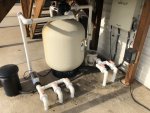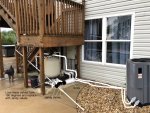Heater Options?
- Thread starter jdebord
- Start date
You are using an out of date browser. It may not display this or other websites correctly.
You should upgrade or use an alternative browser.
You should upgrade or use an alternative browser.
- Jul 21, 2013
- 52,271
- Pool Size
- 35000
- Surface
- Plaster
- Chlorine
- Salt Water Generator
- SWG Type
- Pentair Intellichlor IC-60
Connect the heater between your filter and SWG.
What model heater are you planning to get?
What model heater are you planning to get?
I haven’t decided - any recommendations? Just looking for configuration ideas right now. I know it needs to be plumbed after the filter, but there isn’t really room to drop a heater in there the way it sits.
- Jul 21, 2013
- 52,271
- Pool Size
- 35000
- Surface
- Plaster
- Chlorine
- Salt Water Generator
- SWG Type
- Pentair Intellichlor IC-60
How about a bunch of information about the pool you want to heat?
Please create your signature about your pool and equipment. And put a location in your profile.
Gas? Propane? Heat pump?
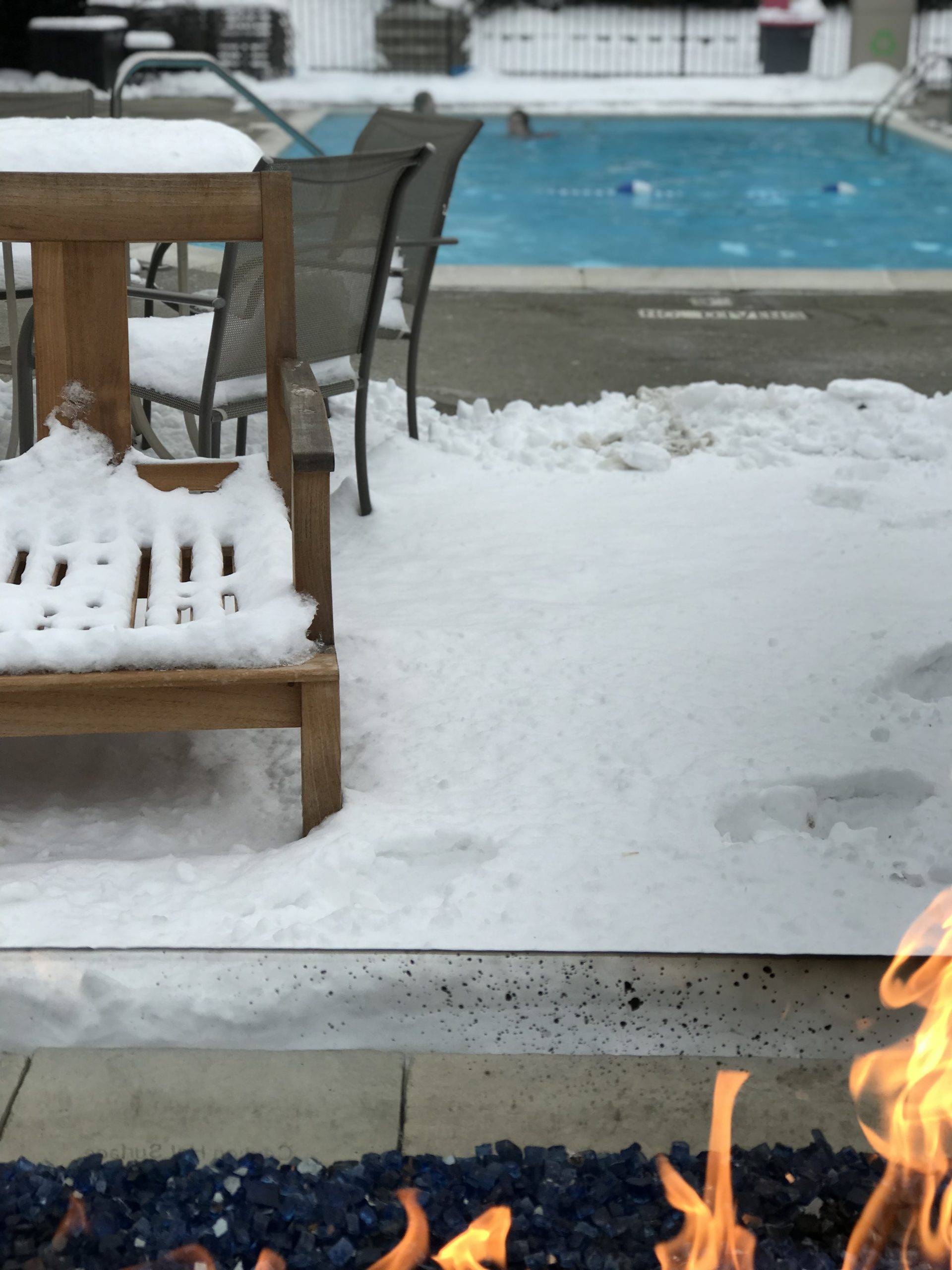
 www.troublefreepool.com
www.troublefreepool.com
Pool Heating Calculators
Post wider pics of your equipment area.
Please create your signature about your pool and equipment. And put a location in your profile.
Gas? Propane? Heat pump?

Pool Heaters Explained
What good is clear water if the water temperature is to cold to enjoy it? We've answered some questions and provided simple tips to understand pool heaters.
Pool Heating Calculators
Post wider pics of your equipment area.
- Apr 27, 2018
- 150
- Pool Size
- 11000
- Surface
- Vinyl
- Chlorine
- Salt Water Generator
- SWG Type
- CircuPool Edge-25
I would put the heater behind the sand filter, from the perspective of the picture you posted. Piping would come out the front of the sand filter, turn around and go back to the heater, and then come back forward from the heater to the SWG.
As for which one to choose, I bought a Raypak last year which I like a heck of a lot better than the Hayward it replaced.
As for which one to choose, I bought a Raypak last year which I like a heck of a lot better than the Hayward it replaced.
It’s a free form in-ground salt water pool. I don’t have exact specs, but I’m guessing 17k gallon. Sand filter with an intelliflo variable speed pump. I was thinking gas for the heater, but between space constraints and building codes, I’m not sure where it could go. I’d like to keep it all compact.
below are some wider pics as requested.
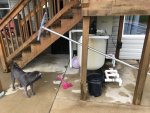
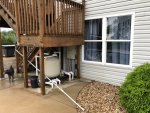
below are some wider pics as requested.


- Jun 7, 2017
- 9,016
- Pool Size
- 29000
- Surface
- Plaster
- Chlorine
- Salt Water Generator
- SWG Type
- Jandy Aquapure 1400
Yeah nothing easy about that setup. Only real place to put it is directly in front of the SWG on the actual pathway/concrete. Not in front of the window and not enough room under the deck. Where are you located? You could possibly move it off to the right of the picture where that bush is maybe on the side of the house? In that case you'd need to extend some piping over to it of course. Gas heaters are very location specific because of their exhaust (windows/decks/etc).
I would put the heater behind the sand filter, from the perspective of the picture you posted. Piping would come out the front of the sand filter, turn around and go back to the heater, and then come back forward from the heater to the SWG.
As for which one to choose, I bought a Raypak last year which I like a heck of a lot better than the Hayward it replaced.
My hayward is getting old and I haven't been a big fan of it..Does the Raypak heat better?
PoolBrews
Well-known member
- Oct 16, 2019
- 551
- Pool Size
- 6750
- Surface
- Plaster
- Chlorine
- Salt Water Generator
- SWG Type
- Hayward Aqua Rite Pro (T-15)
Curious, what did you like about the Raypak better than the Hayward? Looking at specs, the Hayward 140K unit has a COP of 5.7, and the Raypak of the same size is 5.6, so the Hayward is cheaper to run. My pool installer put in the Hayward, and I've had no issues with it - it either heats or it doesn'tI would put the heater behind the sand filter, from the perspective of the picture you posted. Piping would come out the front of the sand filter, turn around and go back to the heater, and then come back forward from the heater to the SWG.
As for which one to choose, I bought a Raypak last year which I like a heck of a lot better than the Hayward it replaced.
Looking at the pics above, I see several issues with regards to placement of a heater. Most city codes won't let you place it in front of the window (there is a minimum distance), so in front of the filter is probably out. Behind the filter looks like the heater would be sitting under a set of wooden stairs... there is a minimum clearance above the heater of 6' (at least that is code here in Florida) - they even made the installer move the heater out 6" from the wall because the eave above was closer then 6', so that location is probably out as well. The only location I see would be to the left of the filter, as viewed from the pic, outside of the stairs- unless I'm missing something here.
If I were in the market for replacing my Hayward HP21404T, I would get the AquaCal HeatWave SuperQuiet SQ225. At 144K BTU's, it's COP is 6.5 - far more efficient than either the Hayward or Raypak, and is 10db quieter when running. A win-win in my book.
My Hayward failed after 4 months, control board failed and Hayward said they "might" fix it under warranty if I paid $125 for a service call..I just bought the board.
MIne is 400K and doesn't heat as well as the older one I replaced 7 years ago
MIne is 400K and doesn't heat as well as the older one I replaced 7 years ago
- Jun 7, 2017
- 9,016
- Pool Size
- 29000
- Surface
- Plaster
- Chlorine
- Salt Water Generator
- SWG Type
- Jandy Aquapure 1400
PoolBrews
Well-known member
- Oct 16, 2019
- 551
- Pool Size
- 6750
- Surface
- Plaster
- Chlorine
- Salt Water Generator
- SWG Type
- Hayward Aqua Rite Pro (T-15)
I'm fairly certain that is still too close to the window. This is what my installer told me when picking a spot:
"The top of the heater must be at least 5 feet below, or offset 4 feet from, the nearest opening to a building, such as a window or door; in addition, the top of the heater must be at least 3 feet above any forced-air inlets located within 10 feet of the unit."
"The top of the heater must be at least 5 feet below, or offset 4 feet from, the nearest opening to a building, such as a window or door; in addition, the top of the heater must be at least 3 feet above any forced-air inlets located within 10 feet of the unit."
- Jun 7, 2017
- 9,016
- Pool Size
- 29000
- Surface
- Plaster
- Chlorine
- Salt Water Generator
- SWG Type
- Jandy Aquapure 1400
I'm fairly certain that is still too close to the window. This is what my installer told me when picking a spot:
"The top of the heater must be at least 5 feet below, or offset 4 feet from, the nearest opening to a building, such as a window or door; in addition, the top of the heater must be at least 3 feet above any forced-air inlets located within 10 feet of the unit."
This only pertains to a gas heater.
Doggy approved
- Apr 27, 2018
- 150
- Pool Size
- 11000
- Surface
- Vinyl
- Chlorine
- Salt Water Generator
- SWG Type
- CircuPool Edge-25
My hayward is getting old and I haven't been a big fan of it..Does the Raypak heat better?
It certainly heats better than the Hayward did at the end.
Curious, what did you like about the Raypak better than the Hayward? Looking at specs, the Hayward 140K unit has a COP of 5.7, and the Raypak of the same size is 5.6, so the Hayward is cheaper to run. My pool installer put in the Hayward, and I've had no issues with it - it either heats or it doesn't, so I'm curious as to what makes the Raypak better from your experience.
My Hayward H150 Milivolt required service a couple of times every year. Occasionally I was able to do it--cleaning, replacing thermocouple, replacing gas valve, etc. But other times the pressure or temperature switches failed and needed to be replaced, we had a tech out for that. The pilot would blow out a few times a year, and it was kind of a pain to make sure it stayed lit. Then last year it melted all the fins off the heat exchanger and stopped heating entirely.
So when we went to the Raypak, I got the digital instead of the millivolt. Eliminates the standing pilot and thermocouple (which should make up for the efficiency right there), gives precise control of temperature along with a temperature readout. Very happy so far, even though it's only been a year.
If I were in the market for replacing my Hayward HP21404T, I would get the AquaCal HeatWave SuperQuiet SQ225. At 144K BTU's, it's COP is 6.5 - far more efficient than either the Hayward or Raypak, and is 10db quieter when running. A win-win in my book.
Oh, now I see you're talking about Heat Pumps, not heaters. I have no opinions in that space, never having used one.
PoolBrews
Well-known member
- Oct 16, 2019
- 551
- Pool Size
- 6750
- Surface
- Plaster
- Chlorine
- Salt Water Generator
- SWG Type
- Hayward Aqua Rite Pro (T-15)
This was for my heat pump in Florida. The inspector in Marion County made them move the heater about 6" because it was too close to a window and barely under the eave of the home.This only pertains to a gas heater.
- Jun 7, 2017
- 9,016
- Pool Size
- 29000
- Surface
- Plaster
- Chlorine
- Salt Water Generator
- SWG Type
- Jandy Aquapure 1400
This was for my heat pump in Florida. The inspector in Marion County made them move the heater about 6" because it was too close to a window and barely under the eave of the home.
Interesting I have never heard of a NEC or local code for Heat Pump placement. Usually the only rules are adequate access to the HP controls (30" or so). Many inspectors do not know the law and make it up as they go but perhaps FL does have some local rules.
- Jul 21, 2013
- 52,271
- Pool Size
- 35000
- Surface
- Plaster
- Chlorine
- Salt Water Generator
- SWG Type
- Pentair Intellichlor IC-60
Raypak HP manual ( https://cdn.globalimageserver.com/FetchDocument.aspx?ID=A6A43ED9-CCB9-4449-B4AF-AF6111D27828 ) says:
This unit features an ‘up-flow’ discharge for quiet operation. Air is pulled up through the evaporator coil and discharged through the top grille. Allow at least 5 ft (1.5 m) clearance above the unit for unrestricted air discharge. DO NOT install the unit under a porch or deck. Refer to Fig. 1. Recirculation of cold discharge air back into the evaporator coil will greatly reduce the unit’s heating capacity and efficiency.
It is important to keep the area next to the heat pump pool heater clear of shrubs, bushes and chemicals containers. They could prevent air from circulating fully through the heat pump pool heater, and will affect the operation of the heat pump pool heater or damage the heat pump pool heater.
This unit features an ‘up-flow’ discharge for quiet operation. Air is pulled up through the evaporator coil and discharged through the top grille. Allow at least 5 ft (1.5 m) clearance above the unit for unrestricted air discharge. DO NOT install the unit under a porch or deck. Refer to Fig. 1. Recirculation of cold discharge air back into the evaporator coil will greatly reduce the unit’s heating capacity and efficiency.
It is important to keep the area next to the heat pump pool heater clear of shrubs, bushes and chemicals containers. They could prevent air from circulating fully through the heat pump pool heater, and will affect the operation of the heat pump pool heater or damage the heat pump pool heater.
- Jun 7, 2017
- 9,016
- Pool Size
- 29000
- Surface
- Plaster
- Chlorine
- Salt Water Generator
- SWG Type
- Jandy Aquapure 1400
Raypak HP manual ( https://cdn.globalimageserver.com/FetchDocument.aspx?ID=A6A43ED9-CCB9-4449-B4AF-AF6111D27828 ) says:
This unit features an ‘up-flow’ discharge for quiet operation. Air is pulled up through the evaporator coil and discharged through the top grille. Allow at least 5 ft (1.5 m) clearance above the unit for unrestricted air discharge. DO NOT install the unit under a porch or deck. Refer to Fig. 1. Recirculation of cold discharge air back into the evaporator coil will greatly reduce the unit’s heating capacity and efficiency.
It is important to keep the area next to the heat pump pool heater clear of shrubs, bushes and chemicals containers. They could prevent air from circulating fully through the heat pump pool heater, and will affect the operation of the heat pump pool heater or damage the heat pump pool heater.
All HP makers have similar instructions They have to do with proper operation and longevity of the HP. Have you heard of any building codes for HP placement?
- Jul 21, 2013
- 52,271
- Pool Size
- 35000
- Surface
- Plaster
- Chlorine
- Salt Water Generator
- SWG Type
- Pentair Intellichlor IC-60
Have you heard of any building codes for HP placement?
No. But I have not needed to install a HP yet. We hear about code inspectors with various interpretations between what is required code and what is best practices. If you want to engage the inspector then ask him to cite a reference.
Thread Status
Hello , This thread has been inactive for over 60 days. New postings here are unlikely to be seen or responded to by other members. For better visibility, consider Starting A New Thread.
Similar threads
- Replies
- 3
- Views
- 46
- Replies
- 8
- Views
- 297
- Replies
- 1
- Views
- 168
- Replies
- 6
- Views
- 114


